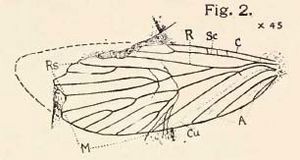Mesochorista proavita facts for kids
Quick facts for kids Mesochorista proavita |
|
|---|---|
 |
|
| Scientific classification | |
| Genus: |
Mesochorista
|
| Species: |
proavita
|
| Synonyms | |
|
†Eoses triassica |
|
Mesochorista proavita is an extinct species of scorpionfly that lived a very long time ago during the Triassic period. Its fossils have been found in Queensland, Australia.
Discovery of an Ancient Insect
The first fossils of Mesochorista proavita were found and described in 1916 by an English-Australian scientist named Robert John Tillyard. He was an entomologist, which means he studied insects.
These ancient insect fossils were discovered in a place called the Denmark Hill Insect Bed in Queensland, Australia. The rocks where they were found are part of the Blackstone Formation. Scientists have figured out that these rocks are from the Carnian age, which was about 228 to 216.5 million years ago! That's an incredibly long time ago, even before the biggest dinosaurs roamed the Earth.
Another insect fossil, called Eoses triassica, was found in 1945 by another Australian entomologist, Norman Tindale. These fossils were found in the Mt. Crosby Insect Bed in Queensland, Australia, and are also from the Carnian age. Some scientists think Eoses triassica might be the same species as Mesochorista proavita.
Understanding its Family Tree
M. proavita belongs to a group of insects called Permochoristidae. This group is part of the larger order of insects known as Mecoptera, which are commonly called scorpionflies. They get their name because some male scorpionflies have a tail-like structure that looks a bit like a scorpion's stinger, though it's harmless.
For a while, there was a scientific debate about whether Eoses triassica was the same as M. proavita. In 1955, a scientist named E.F. Riek suggested that Eoses triassica was actually just another example of M. proavita. He also said that it was a scorpionfly, not a lepidopteran (which are butterflies and moths), as it was first thought to be.
However, Norman B. Tindale, the scientist who first found Eoses triassica, disagreed in 1980. He pointed out differences in the wing patterns and believed that the three known fossils of Eoses triassica were actually a type of ancient moth, belonging to the family Eocoronidae. This shows how scientists can sometimes have different ideas about how to classify ancient creatures based on the evidence they find.

